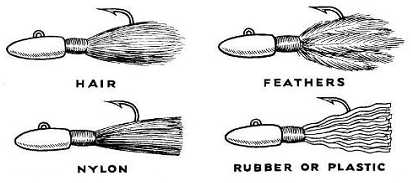|
Fishing JigsJigs Tend To Be Lost Easily -
|
Somewhat similar but a bit more expensive are "water putty" and "crack filler" which also come in powder
form in containers and are mixed with water. Most hardware or paint stores carry them.
Another material which can be used is "iron paste" or "iron cement," which comes in powdered form too. You also add water and this makes a heavy paste for pouring the mold. Most hardware stores carry it.
There are also many kinds of dental cements and plasters which can be used to make temporary molds. Ask your dentist to suggest one or two of these. Or you can go to a dental supply house and ask for such a cement.
After casting your own fishing jigs, the next step is to tie on a body or skirt of bucktail hair, feathers or nylon for jig tying .
Bucktail hair and feathers can usually be bought in small packages in almost any fishing tackle store, or you can send away for these materials to one of the fly-tying supply houses.
Nylon jig hair can be fashioned in various colors and lengths. It comes in the natural translucent color of nylon, in different diameters and lengths, and is dyed with special nylon dyes available from supply houses.
The small diameters and lengths are best for small jigs, especially those used in freshwater fishing, and the thicker diameters and longer lengths are used for the larger saltwater jigs.
When tying the nylon jig hair, great care must be taken to do this as tightly as possible, because this material has a tendency to slip out from under the wrapping. For best results, try to get the "crimped" nylon which holds better than the smooth kind.
Instead of bucktail hair you can tie feathers of different skirts on the jig. See illustration below. Neck or saddle hackle feathers are best for this. Although various colors of feathers are used, white and yellow are the most popular for both freshwater and saltwater fishing.
The final step in making fishing jigs is to paint the metal head in whatever color you prefer. Most jigs range in weight from 1/8 oz. to about 2 ozs. The smaller ones are best for freshwater fishing and for casting with light outfits.
The heavier ones are more suited for saltwater fishing, trolling, and casting with heavy fishing tackle. Fishing jigs are so easy and inexpensive to make that every freshwater and saltwater angler should make jig molds or buy molds to turn out a good supply and assortment of these lures to be prepared for the fishing season.
JIG AWAY...
|
| Freshwater Fishing | Bass Fishing | Saltwater Fishing | | Fishing Spoons | Fishing Spinners | Fishing Jigs | | Sinkers | Making Fishing Leaders | Hand Tools | | Link To Us | Contact Us | Preferred Partners | About This Site | | Site Map | |
| Back to Top |
Make-Your-Own-Fishing-Lures.com
© 2004 Make-Your-Own-Fishing-Lures.com. All Rights Reserved.




